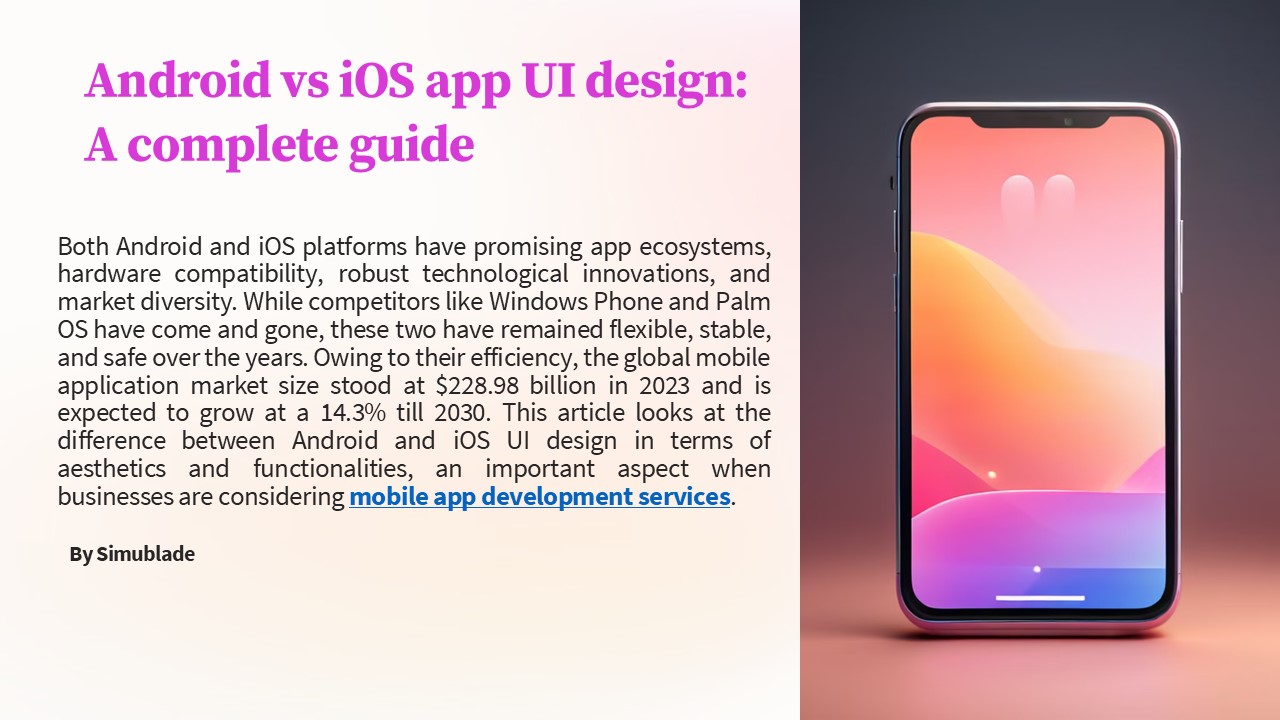Android vs iOS app UI design: A complete guide - PowerPoint PPT Presentation
Title:
Android vs iOS app UI design: A complete guide
Description:
Both Android and iOS platforms have promising app ecosystems, hardware compatibility, robust technological innovations, and market diversity. – PowerPoint PPT presentation
Number of Views:1
Title: Android vs iOS app UI design: A complete guide
1
Android vs iOS app UI design A complete guide
Both Android and iOS platforms have promising
app ecosystems, hardware compatibility, robust
technological innovations, and market diversity.
While competitors like Windows Phone and Palm OS
have come and gone, these two have remained
flexible, stable, and safe over the years. Owing
to their efficiency, the global mobile
application market size stood at 228.98 billion
in 2023 and is expected to grow at a 14.3 till
2030. This article looks at the difference
between Android and iOS UI design in terms of
aesthetics and functionalities, an important
aspect when businesses are considering mobile app
development services.
By Simublade
2
UI Design Rules for Android and iOS
Material design, maintained by Google, is the
standard for developing Android applications.
This includes guidelines for notifications,
fingerprint, snackbars and toasts, launcher
icons, and split screen. Human Interface
Guidelines (HIG), maintained by Apple, contains
best practices for iOS app development, focusing
on crisp elements with minimalism and Apple
technologies. Understanding these design
compliance ideas is crucial for businesses and
designers to ensure design consistency that Apple
and Google expect from apps on their platforms.
3
Navigation Differences
2
3
1
Android Navigation
iOS Navigation
Back Navigation
Android apps have a dedicated 'back' button,
while iOS users rely on a software-based
solution, swiping from left to right or using an
on-screen back button.
iOS follows a tab-based navigation pattern with a
flat, top-level navigation component offering
access to all destinations. Secondary navigation
is typically found in a global navigation bar at
the bottom.
Android follows a hierarchical navigation pattern
with a hamburger menu and floating action bars,
allowing access to all app destinations stacked
on top of each other.
4
Buttons and Gestures
Buttons
Gestures
Android uses Floating Action Buttons (FABs) with
shadows, placed on the top navigation bar. iOS
has flat buttons on the top or bottom navigation
bars.
Android offers a detailed range of gestures like
tapping, swiping, and long-press. iOS has limited
gestures like swipe, pinch, zoom, and tap, but
focuses on highly immersive experiences.
5
Icons and Typography
Icons
Typography
Android and iOS icons follow different grid
structures, but both must reflect
professionalism, flexibility, and brand identity
to boost visibility and user engagement.
Android uses the Roboto font, while iOS apps
employ the San Francisco font. Both focus on
readability and brand tone, with Android
emphasizing white space and iOS prioritizing text
hierarchy.
6
Scrolling and Search
Scrolling
Android uses a Scroll View option for vertically
scrollable views, while iOS hides the navigation
bar as the user scrolls, providing a more
immersive experience.
Search
Android has a floating search bar with cancel
query and cancel search options, while iOS offers
'hidden' and 'prominent' search bars with clean
query and clean search features.
7
Call-to-Action Buttons
Android CTA
Android app pages have the CTA in the
bottom-right as a Floating Action Button (FAB).
iOS CTA
On iOS, the CTA appears in the upper-right corner
of the screen.
8
Porting Apps Between Platforms
Repurposing
It's possible to design Android apps to look like
iOS, and vice versa, through a process called
repurposing or cloning.
Benefits
This saves time and resources, allows targeting
different user segments, and provides massive
customization scopes.
Conversion
Brands can also port their apps from Android to
iOS and vice versa, with the help of experienced
designers who ensure compatibility and UI/UX
design changes.
9
Thank You













![How to Build an Airbnb-like App? [Complete Guide] PowerPoint PPT Presentation](https://s3.amazonaws.com/images.powershow.com/10002415.th0.jpg?_=20240222033)















![How To Hire Android App Developers For Your Upcoming Project In 2023? [Step-by-Step Guide] PowerPoint PPT Presentation](https://s3.amazonaws.com/images.powershow.com/9858928.th0.jpg?_=20230228066)

